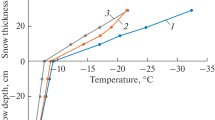The SNOWPOWER measurement method combining high- and low-frequency measurements has been tested under Canadian cold temperate climate for determination of liquid water content and density of a snow pack. Since, cold and shallow seasonal snow pack are very often found in northern environment, it was shown that both snow temperature and exponent coefficient of common dielectric mixing models have to be considered to improve measurement accuracy. Indeed, Looyenga’s mixing-model coefficient at the fourth order together with the weighted average snow temperature measured along the sensor cable and calculated by linear or and cubic spline interpolation provided the most accurate results and good correspondence with manual snow density and snow liquid water content measurements. The best accuracy for snow density shows a relative error of 0.70% and an absolute error of 2.5 kg/m−3 compared to the reliable reference measurements. The mean relative error on the liquid water content was 0.62% and the absolute error 0.15%. The SNOWPOWER sensor system seems to have promising chances to become an operational tool for large-scale monitoring of the snow cover properties.
Similar content being viewed by others
References
Clair T.A. and Ehrman J.M. (1988). Using neural networks to assess the influence of changing seasonal climates in modifying discharge, dissolved organic carbon, and nitrogen export in eastern Canada rivers. Water Resour. Res. 34: 447–455
Jones, H.G., van Bochove, E., and Bertrand, N., 1999, The transmission of soil gases through seasonal snow cover: An experiment to determine the diffusivity of N2O in snow in situ, in Tranter, M. et al. eds., Interactions Between the Cryosphere, Climate and Greenhouse Gases. Proc. of IUGG 99 Symposium HS2, Birmingham, July 1999, IAHS Publ. No. 256, p. 237–244.
van Bochove E., Jones H.G., Bertrand N., and Prévost D. (2000). Winter fluxes of greenhouse gases from snow covered agricultural soil: intra- and interannual variations. Global Biogeochem. Cycles 14:113–125
Martin D., Bernier M., Sasseville J.L., and Charbonneau R. (1999). Évaluation financière de l’intégration de technologies satellitaires pour le suivi du couvert nival, au sein d’une entreprise hydroélectrique. Int. J. Remote Sens. 20(6):2033–2048
Stein J., Gaetan L., and Lévesque D. (1997). Monitoring the Dry Density and the Liquid Water Content of Snow Using Time Domain Reflectometry (TDR). Cold Reg. Sci. Technology 25:123–136
Mätzler C. (1996). Microwave permittivity of dry snow. IEEE Transactions on Geoscience and Remote Sensing 34: 573–581
Denoth A. (1994). Snow dielectric measurements. Adv. Space Res. 9:233–243
Brandelik, A., and Huebner, C., 1997, Large-area, long-term monitoring of mineral barrier materials: Proc. of the 1997 International Containment Technology Conference and Exhibition, St. Petersburg, Florida, February 9–12, p. 1060–1066.
Hübner, C., and Brandelik, A., 2000, Distinguished Problems in Soil and Snow Aquametry: Sensors Update, Chapter 13, in Baltes, H., Goepel, W., and Hess, J., eds. v. 7 p. 317–340.
Stähli, M., Gustafsson, D., Stacheder, M., Bernier, M., Niang, M., Chokmani, K., Savary, S., van Bochove, E., Sommer, W., and Völksch, 2005, Test of a new in-situ snow sensor for validation of remote sensing images, EARSEL Proc. Berne, February 2005, 12 pages.
Hasted J.B. (1999). Aqueous Dielectrics. Chapman and Hall ltd, London
Petrenko V.F. and Whitworth R.W. (1999). Physics of Ice. Oxford University Press, New York
Ulaby F.T., Moore R.K., and Fung A.K. (1986). Microwave dielectric properties of natural earth materials. In: Ulaby F.T., Moore R.K., and Fung A.K. (eds) Microwave remote sensing – Vol III: From theory to applications. Artech House, Norwood (USA), pp. 2017–2027
Birchak J.R., Gardner L.G., Hipp J.W., and Victor J.M. (1974). High dielectric constant microwave probes for sensing soil moisture. Proc. IEEE 62:93–98
Looyenga H. (1965). Dielectric constant of heterogeneous mixtures. Physica 31:401–406
Tiuri M.E., Sihvola A.H., Nyfors E.G., and Hallikainen M.T. (1984). The complex dielectric constant of snow at microwave frequencies: IEEE J. Ocean. Eng. 5:377–382
Huebner, C., 1999, Entwicklung hochfrequenter Messverfahren zur Boden- und Schneefeuchtemessung, Wiss. Berichte FZKA 6329, 1999; Forschungszentrum Germany.
Marsh, P. and Woo, M.-K., 1984, Wetting front advance and freezing of meltwater within a snow cover: 1. Observations in the Canadian Arctic, Water Resour. Res. 1984; v. 20 (12), p. 1853–1864
Author information
Authors and Affiliations
Corresponding author
Rights and permissions
About this article
Cite this article
Niang, M., Bernier, M., Stacheder, M. et al. Influence of Snow Temperature Interpolation Algorithm and Dielectric Mixing-Model Coefficient on Density and Liquid Water Content Determination in a Cold Seasonal Snow Pack. Subsurf Sens Technol Appl 7, 1–22 (2006). https://doi.org/10.1007/s11220-006-0020-9
Received:
Revised:
Published:
Issue Date:
DOI: https://doi.org/10.1007/s11220-006-0020-9




